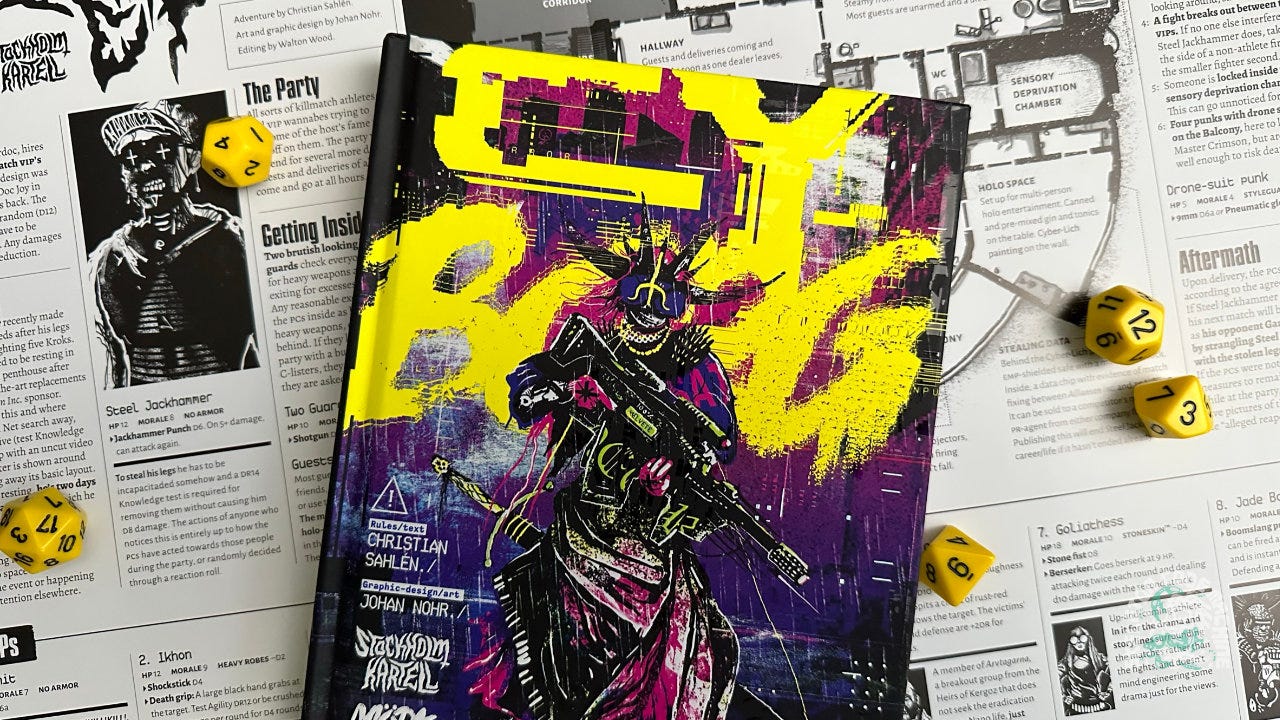Usability testing in tabletop games
Save Against Fear, CY_BORG, usability testing, and Paladins
TL;DR Summary
💀 Save Against Fear Convention
🤖 Compatible with CY_BORG
🧪 Usability testing in tabletop games
🎲 Recently played: Paladins of the West Kingdom
💀 Save Against Fear Convention
I’m happy to announce that Exeunt Press will have a vendor booth at the Save Against Fear tabletop game convention this November!
The convention is November 9-12, 2023 in York, PA. That’s about 2 hours west of Philadelphia, and 1 hour north of Baltimore.
The event is hosted by The Bodhana Group, a 501(c)(3) nonprofit organization that advocates and utilizes tabletop gaming as a directed therapeutic and clinical practice.
New zine editions of Exclusion Zone Botanist, You are a Muffin, and Eleventh Beast (pogs!!!) will be the featured products. Stickers, art prints, shirts, and dice too. If you can attend, I’d love to say hi!
Tickets & Details: Save Against Fear
🤖 Compatible with CY_BORG
Preparations for #MÖRKTOBER continue! It begins October 1, 2023!
Skeleton Code Machine has the resources you need to join in:
And a few from Exeunt Omnes too:
Join the #MÖRKTOBER channel on the MÖRK BORG Discord for discussion and a great place to share your creations.
MÖRKTOBER Prompts & FAQ: www.morktober.com
🧪 Usability testing in tabletop games
This week I watched Root: A Usability Postmortem presented by Joshua Yearsley, Developer & Editor at Leder Games. It was presented at GDC 2021.
Some thoughts based on my notes:
Usability in games: Is it easy to learn, easy to play, easy to use the components? Does it provide a good experience from box open to box close?
Icon testing: Is the icon recognizable, understandable, and distinguishable? Fun example of the Teapot Ghost Mouse Monkey icon in root. Does it scale? Some features get lost and it becomes indistinguishable when reduced in size.
Storytelling: Some mechanisms help with storytelling, such as “defecting characters” when giving cards to Root’s Woodland Alliance. The Workshop mechanism in Root didn’t have this. Players expected they should “do something” with the workshops, and even the physical act of flipping the workshop token could help. Consider how physical interactions and storytelling combine in tabletop games.
Restrictive affordances: Affordances are clues to the user on how to interact with the system (e.g. smaller, round holes on can recycling bins), and make it easier to do the right thing. Examples: Double-layer player boards that only fit one shape, or removing a token shows what to do under it (e.g. +2 VP). Extremely narrow player focus when interacting with board. Cues under the piece are better than next to the piece. This concept reminds me of poke-yoke in manufacturing.
False prompts: Some affordances and prompts can be confusing to users. Example of making a box to store crafted item tokens that happened to fit exactly three token next to each other. Players assumed you could store only three. Play testing is how to catch these issues.
Playtest in bars: Find noisy and suboptimal environments to do your playtesting vs. just quiet rooms.
Expecting meaning in subtle differences: People pick up on small differences in user interface design (e.g. player boards) and will assume everything is meaningful.
Context and concept unsteadiness: Players will draw conclusions based on the context given. If almost everything on a player board behaves a certain way or means one thing, they will infer that same meaning for other items on the board.
Decoupling vs. contextualizing norms: The “decoupling” method reads game rules in isolation, free of context, and assumes everything must be read literally (e.g. classic hex and counter wargame rules). The “contextualizing” method adds context and implications, not just the literal rules as written. How players approach the game may depend on their genre expectations and gaming background.
Synchronous vs. asynchronous teaching: Not everyone learns at the same pace, or is as prepared to teach other players. Allow for the fact that players are busy during their turn, and sometimes between their turns. Allow for asynchronous learning during the game (e.g. overview cards).
This was a really interesting talk, and one I highly recommend you watch. My notes miss the stories that go along with each of these thoughts!
Watch: Root: A Usability Postmortem
🎲 Recently played: Paladins of the West Kingdom
Played my first solo game of Paladins of the West Kingdom (Phillips & Macdonald, 2019) recently. I had played 2-player a couple times before, so was familiar with the game.
It’s a rather complex worker placement game, but one that I’ve found to be really enjoyable. Many paths to victory, points coming from different sources, and it really pushes action efficiency. The AI isn’t too bad to run in the solo game, but can’t really compare to playing against another human.
Looking forward to getting this to the table more often.
Thanks for subscribing to Exeunt Omnes!
Check out games.exeunt.press for all the latest games and resources!
- E.P. 💀





